153P/Ikeya-Zhang comet
Comet Ikeya-Zhang was discovered on February 1st, 2002, by Kaoru Ikeya, (Japan) whilst observing with his 25-cm reflector (X39) and described it as magnitude 9 with a condensed coma 2' across.
Daqing Zhang, (China), discovered it an hour later using a 20-cm reflector and described it as magnitude 8.5 and with a 3' coma.
Paulo M. Raymundo (Brazil) found it also later that day and described it as magnitude 7.5 with a 5' coma.
At discovery the comet was 1.11 AU from the Sun and 1.56 AU from Earth respectively and located in the constellation of Cetus. After discovery, the comet brightened quickly, but low altitude and Moon interference hindered observations. But by February 14th, it was already at magnitude 7, and 6 days later,on the 22nd was magnitude 6. On the 27th it was recorded at magnitude 5.2 and the day after was magnitude 5. By March 12th the magnitude had increased to 4 , with a tail length between 1.5 and 2 deg visible in binoculars. The largest tail length at this time, in very dark skies, was given as 4 degrees in length.
Two Disconnection events were noted in early March; the first occurring on the 3rd , the second on the 11th. By the last week of March the tail was widely reported at 3 degrees in length with a m1=3.4 being recorded. During early April, the comet reached m1=3.3 and was displaying a coma 5'-10' in diameter, as seen with binocular aid, and with a 4 deg tail. After this point , the comet began to fade, and by late April was at magnitude 4.6, with a 2 deg tail but increasing coma size of between 15' and 20' being recorded widely. As May dawned, the tail vanished and the magnitude dropped to 4.8, but the coma diameter remained between 15' and 20'; come months end , the magnitude was down to 6.5 with a coma recorded between 9' and 20' being observed .
Today the comet is: r=29.5 AU, Delta=29.8 AU in Sagittarius .
Comet C/2002 C1 (Ikeya-Zhang) holds the distinction of being the longest periodic comet recorded at 2 returns thanks to the works of Brian G. Marsden and Sayuichi Nakano calculating the two orbits and determining a clear link, but also a comet with the designation of C/1532 R1 must enter into the equation.
The orbital elements are as follows:
C/1532 R1 .
q=0.51
node=93.8
peri=24.5
e=1 (assumed)
i=32.5 deg.
The resemblance is obvious, and as mentioned previously, even Edmond Halley believed C/1532 R1 and C/1661 C1 to be one and the same object. 153P/ has a descending node very close to Jupiter, and as we know, close approaches to this behemoth incur orbital changes at very least but also a possibility of tidal stresses causing a fragmentation event. This event could very likely have occured in around the apparition of 479AD. The orbital period has been decreasing since then gradually by between 10 to 20 years each revolution and evidence strongly suggests that 153P/ is the smaller fragment of the two because Ikeya-Zhang has been decreasing in magnitude as of each revolution around the Sun.
Comet C/1532 R1 had an absolute magnitude , or Ho, of 1.8, only 12 comets listed between 568 AD and 1978 were brighter, Comet C/1661 C1 was Ho=4.6 and C/2002 C1 was Ho 7.2 in value . Now assuming the apparition of 1273 AD, 1661 and 2002 were all Ikeya -Zhang, which they very likely are with 100% certainty, the magnitude has decreased by some 0.5 magnitudes each return, as follows:
1273- m1=2.5
1661- m1=3
2002- m1=3.5.
Another mystery is why Johannes Helvius (Danzica, 28-1-1611/28-1-1687) didn't spot the comet earlier in late December 1660. The return of 1660/61 was the most favourable return of them all , and the comet should have been easily spotted in the evening sky, but wasn't until February 3rd.
On December 31st,1660 the comet was 14 deg high, m1=3 with the Sun 17 deg below the horizon with a new Moon.
5th, January,1661, 15 deg up, m1=2.6, Sun 16 deg below the horizon, crescent moon.
20th January,1661, 12 deg up, m1=0.7, Sun 14 degrees below horizon, Waning moon.
23rd January,1661. 9 deg up, m1=0.4, Sun 13 degrees below horizon. Last quarter.
For those of us in the northern hemisphere, this time of year is notorious for bad weather, but this said, a comet of this magnitude should have been recorded by someone, somewhere, during this most favourable time, would this then infer that the comet was actually dimmer and that the comet experienced a large brightening factor after January ? A mystery indeed .........
Several observations followed in the next days, like E. Welper of Strasbourg, J. Lalemant and Marie de l’Incarnation from Canada. Also reported observations from China, Japan and Korea from Nakano’s study about the linkage of the comet with 153P.
From observations made during 1661 and 2002, a preliminary linked orbit of 53P/Ikeya-Zhang was created. As a result we have the orbital element in the two tables showed here:
153P/ Ikeya-Zhang
|
Epoch |
13-10-2002 |
|
Perihelion |
0.507141 AU |
|
Semi-major axis |
50.76991 AU |
|
Eccentricity |
0.9900127 |
|
Orbital period |
361.75 years |
|
Inclination |
28.12073° |
|
Last perihelion |
18-3-2002 |
|
Next perihelion |
1-9-2362 |
C/1661 C1 Hevelius
|
Epoch |
29-1-1661 |
|
Perihelion |
0.51293 AU |
|
Semi-major axis |
52.40837 AU |
|
Eccentricity |
0.9902128 |
|
Orbital period |
379.40 years |
|
Inclination |
28.06890 |
|
Last perihelion |
5-2-1273 |
|
Next perihelion |
18-3-2002 |
Other linkage:
-Comet 877 DC, this comet was seen around Alpha Andromeda - Gamma Pegasus on 11th Feb in the evening sky in Japan. This comet was seen in the west sky during 15 days in March in Europe
-Comet 1273, was first seen by the Chinese at the ecliptic longitudes of the Hyades and to the north of Auiga. This latter is rather imprecise but still useful for our purposes. Of more use is the statement that the comet subsequently passed from the asterism 28/n/f/q/15 UMa and then penetrated the ‘ladle’ of the Plough. This piece of information effectively limits an Ikeya-Zhang type orbit to having a perihelion passage time between March 26.5 and 28.5. The record then goes on to say that the comet passed through Bootes and reached the region of p Boo. All of this happened, according to Ho’s translation, in 21 days. For our orbit this track would be covered in two months and the end point would be nearer to h Boo. To a certain extent, such details are negotiable (due to possible copying errors etc.) but the time period is something of a problem, as is the visibility for the extended period if the comet were indeed Ikeya-Zhang with its current absolute magnitude.
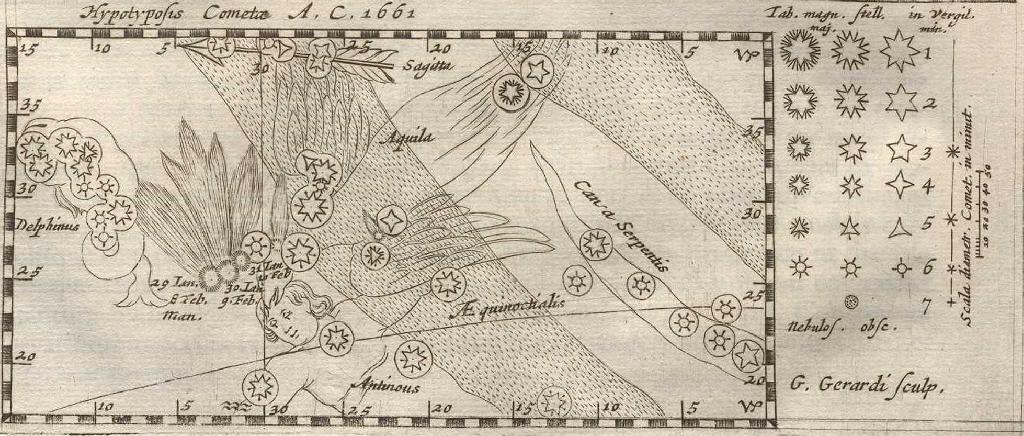
Engraving showing Comet C1661 C1, from S. Lubienietzki (1667) TheatrumCometicum Vol. II (Historia Cometarum, 1666), Amsterdam, The Netherlands. Detail from Diagram No. 77, opposite p.428.

Comet seen by Hevelius from a fragment of F. J. Bertuchs Bilderbuch für Kinder. A book published during the early 800’
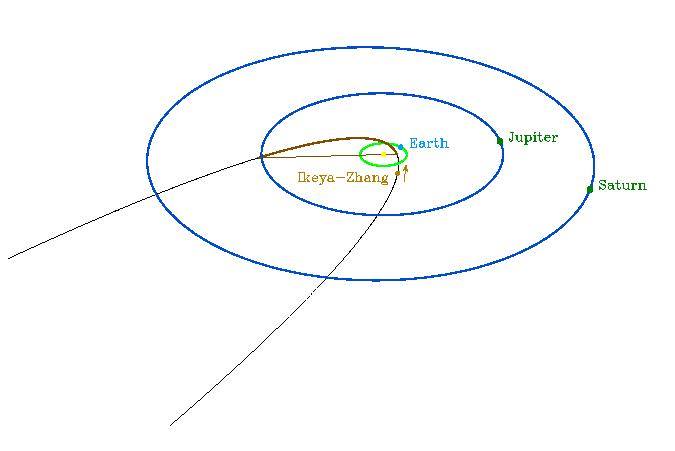
Orbit of 153P/Ikeya-Zhang
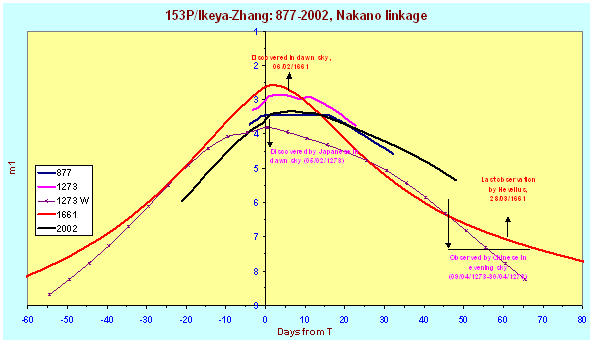
Comparitions of last 5 passage
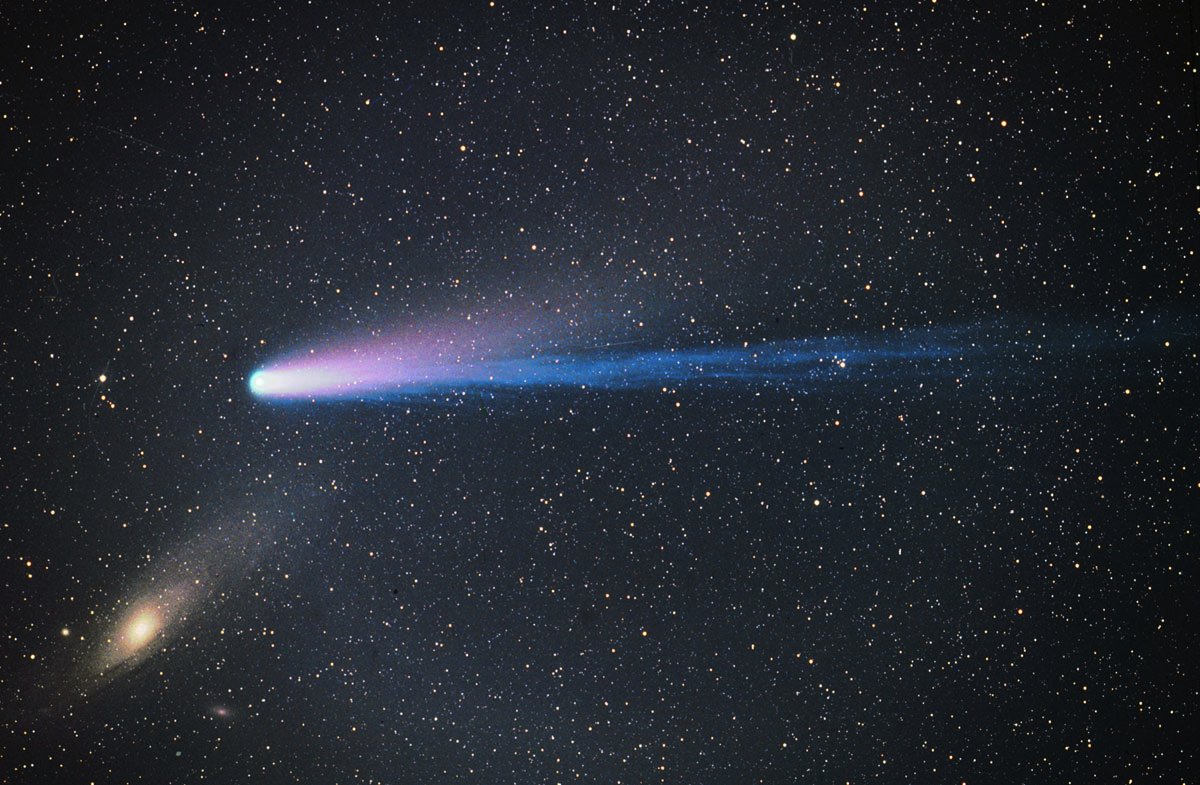
Image took by Gerald Rhemann of 153P on 2 April 2002 with M31
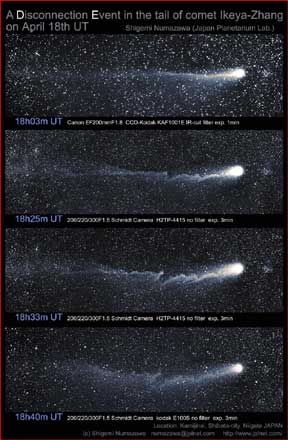
Shigemi Numazawa (Kamijinai, Shibata-city, Niigata, Japan)
back